Μυκήνες
( Mycenae )Mycenae ( my-SEE-nee; Ancient Greek: Μυκῆναι or Μυκήνη, Mykē̂nai or Mykḗnē) is an archaeological site near Mykines in Argolis, north-eastern Peloponnese, Greece. It is located about 120 kilometres (75 miles) south-west of Athens; 11 kilometres (7 miles) north of Argos; and 48 kilometres (30 miles) south of Corinth. The site is 19 kilometres (12 miles) inland from the Saronic Gulf and built upon a hill rising 900 feet (274 metres) above sea level.
In the second millennium BC, Mycenae was one of the major centres of Greek civilization, a military stronghold which dominated much of southern Greece, Crete, the Cyclades and parts of southwest Anatolia. The period of Greek history from about 1600 BC to about 1100 BC is called Mycenaean in reference to Mycenae. At its peak in 1350 BC, ...Read more
Mycenae ( my-SEE-nee; Ancient Greek: Μυκῆναι or Μυκήνη, Mykē̂nai or Mykḗnē) is an archaeological site near Mykines in Argolis, north-eastern Peloponnese, Greece. It is located about 120 kilometres (75 miles) south-west of Athens; 11 kilometres (7 miles) north of Argos; and 48 kilometres (30 miles) south of Corinth. The site is 19 kilometres (12 miles) inland from the Saronic Gulf and built upon a hill rising 900 feet (274 metres) above sea level.
In the second millennium BC, Mycenae was one of the major centres of Greek civilization, a military stronghold which dominated much of southern Greece, Crete, the Cyclades and parts of southwest Anatolia. The period of Greek history from about 1600 BC to about 1100 BC is called Mycenaean in reference to Mycenae. At its peak in 1350 BC, the citadel and lower town had a population of 30,000 and an area of 32 hectares (79 acres).
The first correct identification of Mycenae in modern literature was in 1700, during a survey conducted by the Venetian engineer Francesco Vandeyk on behalf of Francesco Grimani, the Provveditore Generale of the Kingdom of the Morea. Vandeyk used Pausanias's description of the Lion Gate to identify the ruins of Mycenae.
In 1999, the archeological site of Mycenae was added to the UNESCO World Heritage List, along with the nearby site of Tiryns, because of its historical importance as the center of the Mycenaean civilization, its outstanding architecture, and its testimony to the development of Ancient Greek civilization.
The Lions Gate, the Treasury of Atreus, and the walls of Tiryns are examples of the noteworthy architecture found in Mycenae and Tiryns. These discoveries' structures and layouts exemplify the human creative talent of the time. Greek architecture and urban planning have been significantly influenced by the Mycenaean civilization. Mycenae and Tiryns, which stand as the pinnacle of the early phases of Greek civilization, provided unique witness to political, social, and economic growth during the Mycenaean civilization. The accomplishments of the Mycenaean civilisation in art, architecture, and technology, which inspired European cultures, are also on display at both locations.
These sites are strongly connected to the Homeric epics. The earliest examples of the Greek language are also visible at Mycenae and Tiryn, preserved on linear B tablets.
A stringent legal framework was established to safeguard the integrity of the Mycenae and Tiryns sites against vandalism and other forms of damage and disturbance to the remains. The Hellenic Ministry of Culture and Sports monitors the two archaeological sites. To maintain the quality and conditions of the Mycenaean and Tiryn sites, archaeological study is conducted methodically and systematically.
The Greek Antiquities Law No. 3028/2002, on the "Conservation of Antiquities and Cultural Heritage in General", governs the preservation and protection of the sites. Ministerial Decree No. 2160 of 1964 created and safeguarded the limits of Mycenae in addition to the sites themselves. The Acropolis and the larger surrounding surroundings are also covered by this ministerial decree's extension of protection. Ministerial Decrees No. 102098/4753 of 1956 and 12613/696 of 1991 both provide protection for the Tiryns archaeological site.
 The Tomb of Aegisthus outside the walls of the citadel.Neolithic Age
The Tomb of Aegisthus outside the walls of the citadel.Neolithic Age
Mycenae, an acropolis site, was built on a hill 900 feet (274 metres) above sea level, some 19 kilometres (12 miles) inland from the Gulf of Argolis. Situated in the north-east corner of the Argive plain, it easily overlooked the whole area and was ideally positioned to be a centre of power, especially as it commanded all easy routes to the Isthmus of Corinth. Besides its strong defensive and strategic position, it had good farmland and an adequate water supply.[1] There are only faint traces of Neolithic settlement on the site although it was continuously occupied from the Early Neolithic (EN; c. 5000–c. 4000 BC) through the Early Helladic (EH; c. 3200–c. 2000 BC) and Middle Helladic (MH; c. 2000–c. 1550 BC) periods. EN Rainbow Ware constitutes the earliest ceramic evidence discovered so far.[2]
Early and Middle Bronze AgeThe population had grown considerably by the Middle Helladic. As elsewhere, a dominant Cretan influence prevailed from c. 1600 BC, the first evidence of this coming from the shaft graves discovered in 1876 by Heinrich Schliemann.[1] Schliemann's shaft graves came to be known as Circle A to distinguish them from the Circle B graves which were found at a later date, although Circle B are the earlier graves dated c. 1650 BC to c. 1550 BC and entirely within MHIII. Circle A is dated to the sixteenth century BC, including the transition from Middle to Late Helladic IA (LHIA; c. 1550 – c. 1500 BC).[1] The contents of Circle B are less wealthy than those of Circle A.[3]
Pottery material spanning the entire Early Helladic was discovered 1877 by Panagiotis Stamatakis at a low depth in the sixth shaft grave in Circle A. Further EH and MH material was found beneath the walls and floors of the palace, on the summit of the acropolis, and outside the Lion Gate in the area of the ancient cemetery.[4] An EH–MH settlement was discovered near a fresh-water well on top of the Kalkani hill south-west of the acropolis.[4] The first burials in pits or cist graves manifest in MHII (c. 1800 BC) on the west slope of the acropolis, which was at least partially enclosed by the earliest circuit wall.[4]
Late Bronze Age View from the acropolis, or high city.
View from the acropolis, or high city.In the absence of documents and objects that can be precisely dated, events at Mycenae can only be dated relatively within the constraints of Helladic chronology which relies on categorisation of stratified material objects, mainly pottery, within an agreed historical framework. Mycenae developed into a major power during LHI (c. 1550 – c. 1450 BC) and is believed to have become the main centre of Aegean civilisation through the fifteenth century to the extent that the two hundred years from c. 1400 BC to c. 1200 BC (encompassing LHIIIA and LHIIIB) are known as the Mycenaean Age. The Minoan hegemony was ended c. 1450 and there is evidence that Knossos was occupied by Mycenaeans until it too was destroyed c. 1370 BC. From then on, Mycenaean expansion throughout the Aegean was unhindered until the massive disruption of society in the first half of the twelfth century (LHIIIC) which ended Mycenaean civilisation and culminated in the destruction of Mycenae itself c. 1150 BC.
Late Helladic I (LHI; c. 1550–c. 1450 BC)Outside the partial circuit wall, Grave Circle B, named for its enclosing wall, contained ten cist graves in Middle Helladic style and several shaft graves, sunk more deeply, with interments resting in cists. Richer grave goods mark the burials as possibly regal. Mounds over the top contained broken drinking vessels and bones from a repast, testifying to a more than ordinary farewell.[5] Stelae surmounted the mounds.[6]
A walled enclosure, Grave Circle A, included six more shaft graves, with nine female, eight male, and two juvenile interments. Grave goods were more costly than in Circle B. The presence of engraved and inlaid swords and daggers, with spear points and arrowheads, leave little doubt that warrior chieftains and their families were buried here. Some art objects obtained from the graves are the Silver Siege Rhyton, the Mask of Agamemnon, the Cup of Nestor, and weapons both votive and practical. The chemical compositions of the silver objects indicate that the silver was sourced from several locations.[7]
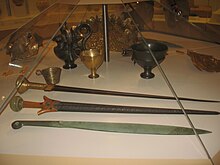 Museum replicas of Mycenaean swords and cups.Late Helladic II (LHII; c. 1450–c. 1400 BC)
Museum replicas of Mycenaean swords and cups.Late Helladic II (LHII; c. 1450–c. 1400 BC)
Alan Wace divided the nine tholos tombs of Mycenae into three groups of three, each based on architecture. His earliest – the Cyclopean Tomb, Epano Phournos, and the Tomb of Aegisthus – are dated to LHIIA.
Burial in tholoi is seen as replacing burial in shaft graves. The care taken to preserve the shaft graves testifies that they were by then part of the royal heritage, the tombs of the ancestral heroes. Being more visible, the tholoi all had been plundered either in antiquity, or in later historic times.
Late Helladic III (LHIII; c. 1400–c. 1050 BC)At a conventional date of 1350 BC, the fortifications on the acropolis, and other surrounding hills, were rebuilt in a style known as Cyclopean because the blocks of stone used were so massive that they were thought in later ages to be the work of the one-eyed giants known as the Cyclopes.[8] Within these walls, much of which can still be seen, successive monumental palaces were built. The final palace, remains of which are currently visible on the acropolis of Mycenae, dates to the start of LHIIIA:2. Earlier palaces must have existed, but they had been cleared away or built over.
The construction of palaces at that time with a similar architecture was general throughout southern Greece. They all featured a megaron, or throne room, with a raised central hearth under an opening in the roof, which was supported by four columns in a square around the hearth. A throne was placed against the center of a wall to the side of the hearth, allowing an unobstructed view of the ruler from the entrance. Frescos adorned the plaster walls and floor.

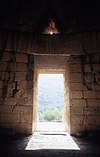
The room was accessed from a courtyard with a columned portico. A grand staircase led from a terrace below to the courtyard on the acropolis.
In the temple built within the citadel, a scarab of Queen Tiye of Egypt, who was married to Amenhotep III, was placed in the Room of the Idols alongside at least one statue of either LHIIIA:2 or B:1 type. Amenhotep III's relations with m-w-k-i-n-u, *Mukana, have corroboration from the inscription at Kom al-Hetan - but Amenhotep's reign is thought to align with late LHIIIA:1. It is likely that Amenhotep's herald presented the scarab to an earlier generation, which then found the resources to rebuild the citadel as Cyclopean and then, to move the scarab here.
Wace's second group of tholoi are dated between LHIIA and LHIIIB: Kato Phournos, Panagia Tholos, and the Lion Tomb. The final group, Group III: the Treasury of Atreus, the Tomb of Clytemnestra and the Tomb of the Genii, are dated to LHIIIB by a sherd under the threshold of the Treasury of Atreus, the largest of the nine tombs. Like the Treasury of Minyas at Orchomenus the tomb had been looted of its contents and its nature as funerary monument had been forgotten. The structure bore the traditional name of "Treasury".
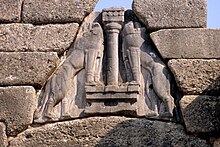 The Lion Gate (detail); two lionesses or lions flank the central column, whose significance is much debated.[9]
The Lion Gate (detail); two lionesses or lions flank the central column, whose significance is much debated.[9]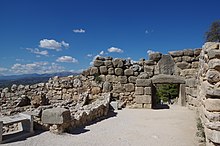 Cyclopean masonry, rear side of the Lion Gate
Cyclopean masonry, rear side of the Lion GateThe pottery phases on which the relative dating scheme is based (EH, MH, LH, etc.) do not allow very precise dating, even augmented by the few existing C-14 dates due to the tolerance inherent in these. The sequence of further construction at Mycenae is approximately as follows. In the middle of LHIIIB, around 1250 BC or so, the Cyclopean wall was extended on the west slope to include Grave Circle A.[10] The main entrance through the circuit wall was made grand by the best known feature of Mycenae, the Lion Gate, through which passed a stepped ramp leading past circle A and up to the palace. The Lion Gate was constructed in the form of a "Relieving Triangle" in order to support the weight of the stones. An undecorated postern gate also was constructed through the north wall.
One of the few groups of excavated houses in the city outside the walls lies beyond Grave Circle B and belongs to the same period. The House of Shields, the House of the Oil Merchant, the House of the Sphinxes, and the West House. These may have been both residences and workshops.
The largest stones including the lintels and gate jambs weighed well over 20 tonnes; some may have been close to 100 tonnes.[11]
Somewhat later, toward the end of LHIIIB around 1200 BC, another, final extension to the citadel was undertaken.[12] The wall was extended again on the northeast, with a sally port and also a secret passage through and under the wall, of corbeled construction, leading downward by some 99 steps to a cistern carved out of rock 15 m below the surface. It was fed by a tunnel from a spring on more distant higher ground.
Already in LHIIIA:1, Egypt knew *Mukana by name as a capital city on the level of Thebes and Knossos. During LHIIIB, Mycenae's political, military and economic influence likely extended as far as Crete, Pylos in the western Peloponnese, and to Athens and Thebes.[13]
DeclineMycenae was among the numerous Aegean sites destroyed as part of the Bronze Age Collapse around 1200 BC. The causes of these destructions are unknown, but proposed explanations include enemy attack, internal strife, and natural disasters such as earthquakes.[14][15][16][17] Unlike many other sites, Mycenae was partly rebuilt after this destruction, though it was no longer the center of a centralized literate bureacuracy. Pottery finds suggest that Postpalatial Mycenae eventually regained some of its wealth, before burning once again. After this period, the site remained sparsely populated until the Hellenistic era.[14][15]
Archaic and classical periodsA temple dedicated to Hera was built on the summit of the Mycenaean citadel during the Archaic Period. A Mycenaean contingent fought at Thermopylae and Plataea during the Persian Wars. In 468 BC, however, troops from Argos captured Mycenae, expelled the inhabitants and razed the fortifications.[18]
Revival and abandonmentMycenae was briefly reoccupied in the Hellenistic period, when it could boast a theatre (located over the Tomb of Clytemnestra). The site was subsequently abandoned, and by the Roman period in Greece its ruins had become a tourist attraction. The ancient travel writer Pausanias, for example, visited the site and briefly described the prominent fortifications and the Lion Gate, still visible in his time, the second century AD. Pausanias also describes being led to the site by shepherds, showing that the surrounding area was never completely abandoned.[19] The Ministry of Culture, Education, and Religious Affairs is currently in charge of the site. In 1999, a scientific committee for Mycenae was created and numerous projects for the preservation, improvement, and stabilization of both archaeological sites have been completed by this scientific body. The committee also sought to improve visitor access to the monuments at the locations by laying out walkways and establishing informational stations.






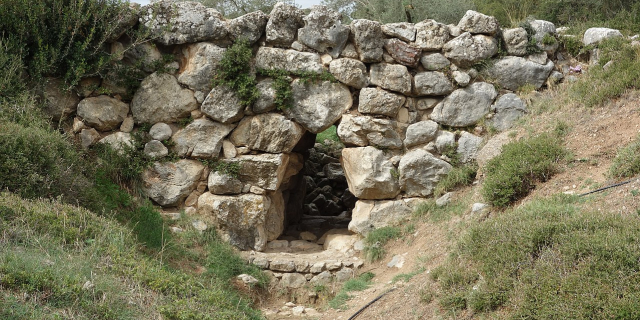

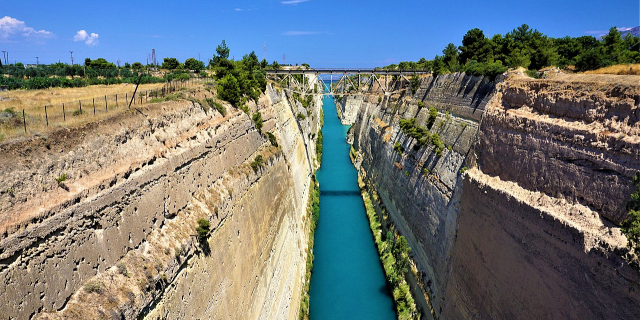


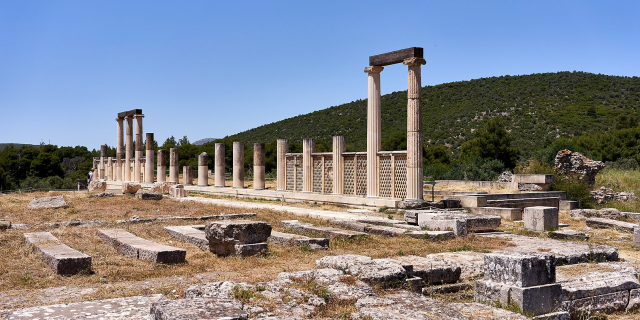


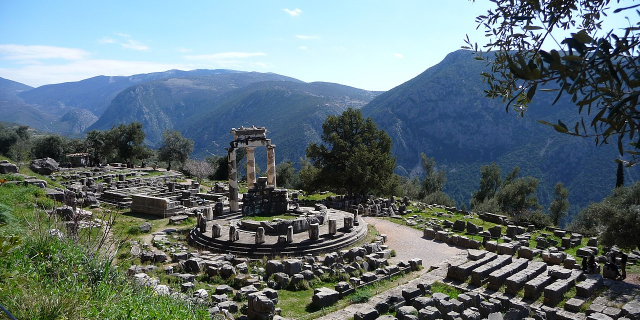



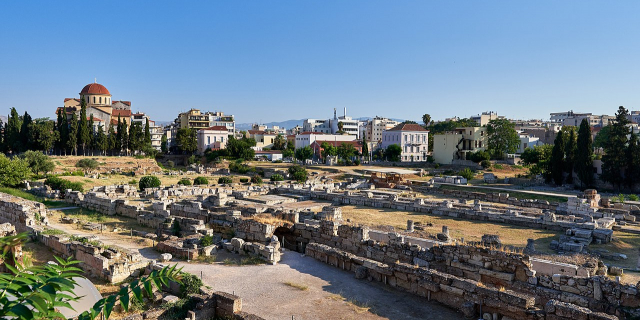
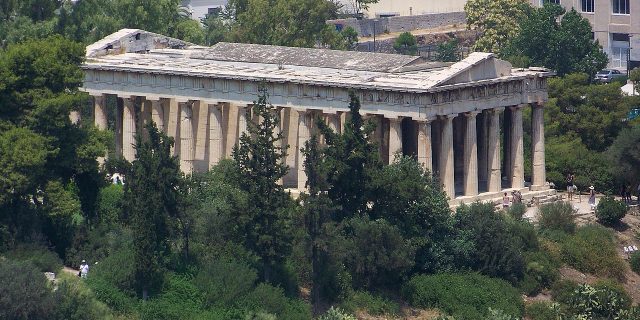



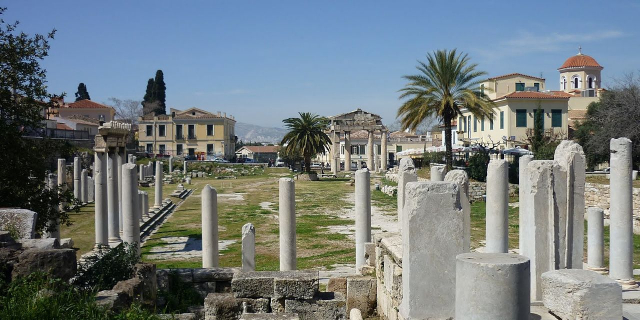
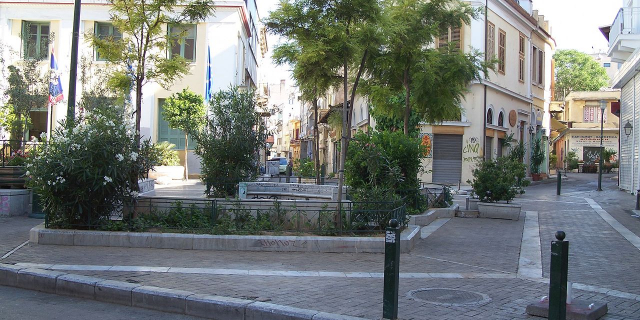



Add new comment